Generally, the generator is an electrical device and the designing of this device can be done by observing the dynamo working principle. Thus, we can say that the generator was progressed from the dynamo invention. The dynamo working is also the same as that of a generator and it was discovered by Hippolyte Pixii in the 1830s. In fact, in a dynamo, the AC (alternating current) is supplied to the armature winding and it is converted through a commutator. Similarly, the same working principle is applicable to the generator also. A dynamo is the first machine that supplies power to the industries. In this article, it covers the basic working of DC generators, different types of DC generators like separately, self-excited types like series, shunt and compound wound type generators based on the arrangement of its winding.
DC Generator can be defined as a machine that alters one form of input to another like from the energy mechanical to electrical for any domestic and commercial usage. Normally, DC generators are used in offices and houses for emergency uses.
Types of DC Generators
The working principle of these generators is electromagnetic induction. An EMF is induced when the coil placed under the magnetic field is rotated by any handle or a prime mover. This induced emf, in turn, induces current to flow in the coil placed under the field. This direction of flow of current can be founded through rule of Fleming’s right-hand. Due to the production of current, a torque is developed that enables the conductors to rotate inside the magnetic field. Based on the direction of current and direction of induced emf, the torque direction can be known. The working of a DC generator is shown in the figure below.
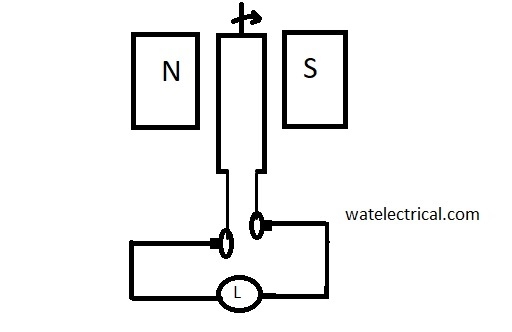
Generator Working
Types of DC Generators & Working
There are different types of generators that we use practically that were categorized based on the excitation and arrangement of winding. They are
- Permanent magnet type
- Separately excited and self-excited
Permanent Magnet Type
The permanent magnets are responsible for the production of flux. The flux generated is by the influence of magnets as the field winding is placed under the influence of magnets. These magnets develop flux when the field winding placed under the influence of the permanent magnetic field is rotated either by using a handle or prime mover. Due to the flux cutting action, the current is induced which is fed to the armature winding which further generates electrical energy.
Please refer to this link to know more about DC Generator MCQs
Types of DC Generators by Excitation Used
Two types of excitation used separately excited and self-excited, whre the type of self excited is further classified as shunt, series, and compound types. The compound type is further categorized into two types like the Long shunt as well as the short shunt. The classification of the DC type generating machine is illustrated in the following block diagram.
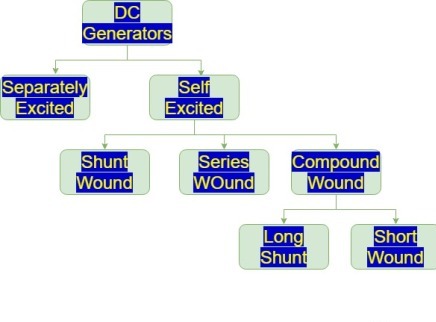
Classification
Separately Excited Type
This type requires a separate excitation for its operation as it cannot supply current to the field winding. So, it requires a separate source to supply current to the field winding such that an emf is induced. The separately excited type diagram is illustrated below.
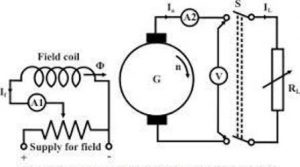
separately excited generator
Self Excited Type
This type does not require any separate excitation the generator itself acts as the source that supplies current to the field winding. The self-excited type is further classified into shunt, series, and compound types. The following details explain the self-excited type with the help of circuit diagrams.
Shunt Type
The field coils are connected in parallel with the applied source. The generator delivers the current which is fed to the required source. The generator armature is represented by A1 and A2 whereas the current delivered is applied across the shunt field winding and also delivered to the required appliance. The current equation is given by Ia = Il + If. The shunt type generator circuit diagram is given below.
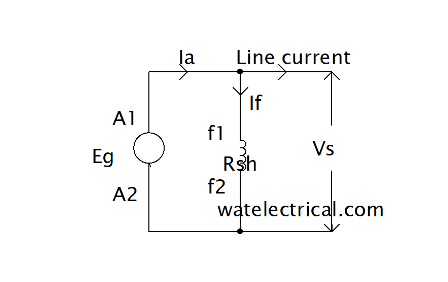
Shunt-Generator Circuit Diagram
Series Type
The series type of winding is employed in series with the armature of the generator. The armature of the generator is denoted by Ia.
The current equation is given by Ia = Il. The line current is equal to the armature current in the case of a series type. The circuit of series type generator is given below.
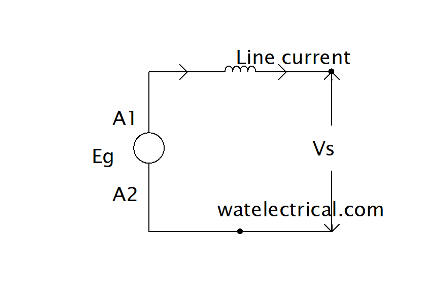
Series-Generator Circuit Diagram
Types of DC Generators by Compound Type
Long Shunt
It is the combination of both the series and shunt type windings. The arrangement differs with the placement of winding. The shunt winding is connected in parallel to both the series field coil and the armature. The current equation is given by Ia = Il – Ish. The long-shunt type generator circuit is displayed below.
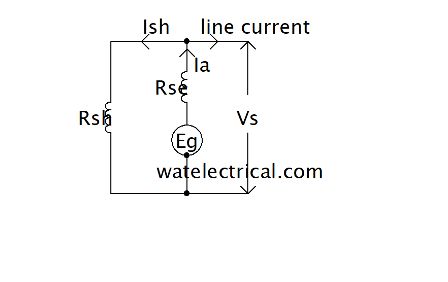
Long-Shunt Generator Circuit Diagram
Short Shunt
It is the combination of both the series and shunt type windings. The advantage of both types is used in this type of connection. The arrangement differs with the placement of winding. The shunt winding is connected in parallel with only the armature winding whereas both the series field coil & armature winding are connected in series with each other . The armature winding is represented by A1 and A2 and field coils by f1 and f2 respectively. The current equation is given by Ia = Il – Ish. The circuit diagram of short-shunt type is given below.

Short-Shunt Generator Circuit-Diagram
Therefore, the above article covers the DC generators basics and the classification of different types of generators. These different types are utilized at a particular place of operation where it suits as unique and every type has its own unique application. It also covers the classifications based on the types of excitation used either self-excited or separately-excited. Here is a question for you, explain the application of different generators in different areas?
Leave a Reply